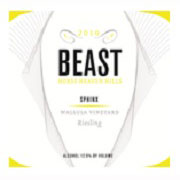Beast, Horse Heaven Hills (Washington) “Sphinx” Riesling, Wallula Vineyard 2012 ($25): As I tasted this wine, the thought occurred to me, “I’d sure hate to have to identify this in a blind tasting!” I hope that I would peg the grape variety correctly because of the intensity of fruity aromas and flavors and the high acidity typical of Riesling — but where in the world could this wine hail from? And what winemaking techniques could produce a wine with such weight and richness without the presence of residual sugar and without high alcohol?
Before I delve into the terroir and the winemaking particulars that make this wine as delicious and intriguing as it is, let me describe just what I tasted. This is a bone dry Riesling with moderate alcohol (12.2 percent)  and very high acidity but it has significant weight, very rich texture, and aromas and flavors of fully ripe fruit (peach, apple, citrus) combined with floral and mineral notes. The first three characteristics — the dryness, moderate alcohol and high acidity — generally would suit a Riesling of slighter build, while the last three characteristics — weight, textural richness and ripeness of fruit — would typically belong to a Riesling with alcohol pushing 13.5 percent, along with some residual sugar, a la Alsace Riesling perhaps.
and very high acidity but it has significant weight, very rich texture, and aromas and flavors of fully ripe fruit (peach, apple, citrus) combined with floral and mineral notes. The first three characteristics — the dryness, moderate alcohol and high acidity — generally would suit a Riesling of slighter build, while the last three characteristics — weight, textural richness and ripeness of fruit — would typically belong to a Riesling with alcohol pushing 13.5 percent, along with some residual sugar, a la Alsace Riesling perhaps.
Despite the breach of logic, this wine comes together beautifully in your mouth. The richness of texture offsets the wine’s dryness and vice versa; the high acidity brings crispness to complement the ripe fruit flavors. It is a flavorful, dynamic white wine of very good quality.
Moving behind the scenes, the grapes for this wine grew in a certified biodynamic part of Wallula Vineyard, one of the most acclaimed sites in Washington for Riesling. The vineyard sits high above the Columbia River at an altitude of more than 1000 feet, a cool site in the warm Horse Heaven Hills AVA. The 2012 growing season was close to ideal, with enough heat to ripen grapes fully and a long growing season that enabled full flavor development without comprising the acidity in the grapes. The grapes for this wine were harvested quite late — November 5 — at a Brix (sugar accumulation) level of only 21 degrees, which is in the low range: Cool climate, high acidity — and yet fully ripe fruit flavors.
At the winery, things also got interesting. One-third of the grapes received about 8 hours of skin contact to enhance the wine’s weight through grape-skin tannins; the remainder did not, thus preserving the essential freshness and vibrancy of the juice. Sixty percent of the juice fermented in stainless steel tanks with ambient yeasts. (One of the effects of ambient yeast fermentations can be textural richness.) The remainder of the juice fermented in neutral French oak barrels of at least five years old, via an Austrian yeast selection; barrel fermentation can give a wine an impression of breadth in the mouth, a kind of weightiness that contrasts with the vertical energy of high acidity. Freshness, vibrancy, weight, textural richness: the pieces fall into place.
Of course this wine is not intended to be a mind game. Apart from all the fun that I’ve had in understanding why it tastes the way it does, Sphinx Riesling is at heart a very good, very well-made and very enjoyable dry Riesling that deserves a place on your table, particularly with seafood salad, or with fish or chicken dishes dressed with lemon.
Beast is a second line of wines produced by Buty Winery. The Beast label includes wines that fall outside the range of six Buty wines and are mainly available just at the winey. However, Sphinx Riesling is available in shops and restaurants nationally, as is its companion red wine Wildebeast — a Columbia Valley red wine whose grape composition changes with the vintage.
90 Points
